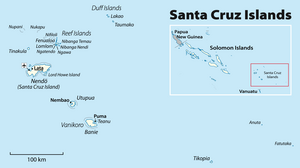Vanikoro


Vanikoro (sometimes known as Vanikolo) is an island from the Santa Cruz group, located 118 km to the Southeast of the main Santa Cruz group. It belongs administratively to the Temotu Province of the Solomon Islands.
The name Vanikoro is always used as though it referred to a single island, due to both its geophysical and cultural unity. However, technically it is a group of several nearby islands surrounded by a single belt of coral reef. Only the two major islands are inhabited: the bigger one Banie, and the smaller one Teanu (or Tevai). Other, uninhabited islets in the Vanikoro group include Manieve, Nomianu and Nanunga. The total area of the Vanikoro group is 173 km².
Population and languages
The 1300 inhabitants of Vanikoro[1] consist of two different populations, who tend to live separately. The Melanesian majority, about 800 people, are the descendants of the original population of Vanikoro. A minority of about 500 individuals are of Polynesian descent; for the last few centuries they have established settlements on the southern coast of Banie, even though they still preserve close links with Tikopia, an island lying 200 km eastwards, which they identify as their origin.
The three languages spoken by the Melanesian population of Vanikoro are all Oceanic, of the Temotu subgroup:[2]
The Tikopian settlers speak a Polynesian language, Tikopian or fakatikopia.
History
First sighting by Europeans was in September 1595 by the second Spanish expedition of Álvaro de Mendaña. More precisely it was sighted by Lorenzo Barreto while in command of one of the smaller vessels on a local voyage round the then called Santa Cruz, which is today's Nendo Island.[3][4]
French explorer Jean-François de La Pérouse was stranded on Vanikoro after both his vessels, La Boussole and the Astrolabe, struck the then unknown reefs of the island in 1788. It is reported[5] that some of the men were killed by the local inhabitants, while the surviving sailors built a smaller vessel and left the island, but were never seen again. Those that remained on the island died before search parties arrived in 1826. Jules Verne dedicates a chapter of his novel Twenty Thousand Leagues Under the Sea to this event.[6]
Notes
- ^ Report on 2009 population & housing census for the Solomon Islands.
- ^ Figures updated in 2012 (site of linguist A. François).
- ^ Sharp, Andrew The discovery of the Pacific Islands Oxford, 1960, pp.52-55.
- ^ Brand, Donald D. The Pacific Basin: A History of its Geographical Explorations The American Geographical Society, New York, 1967, p.136.
- ^ See summary article in The Times, May 13, 2005.
- ^ Verne, Jules (1992). Twenty Thousand Leagues Under the Sea. Hertfordshire: Wordsworth Classics. pp. 81–85.
